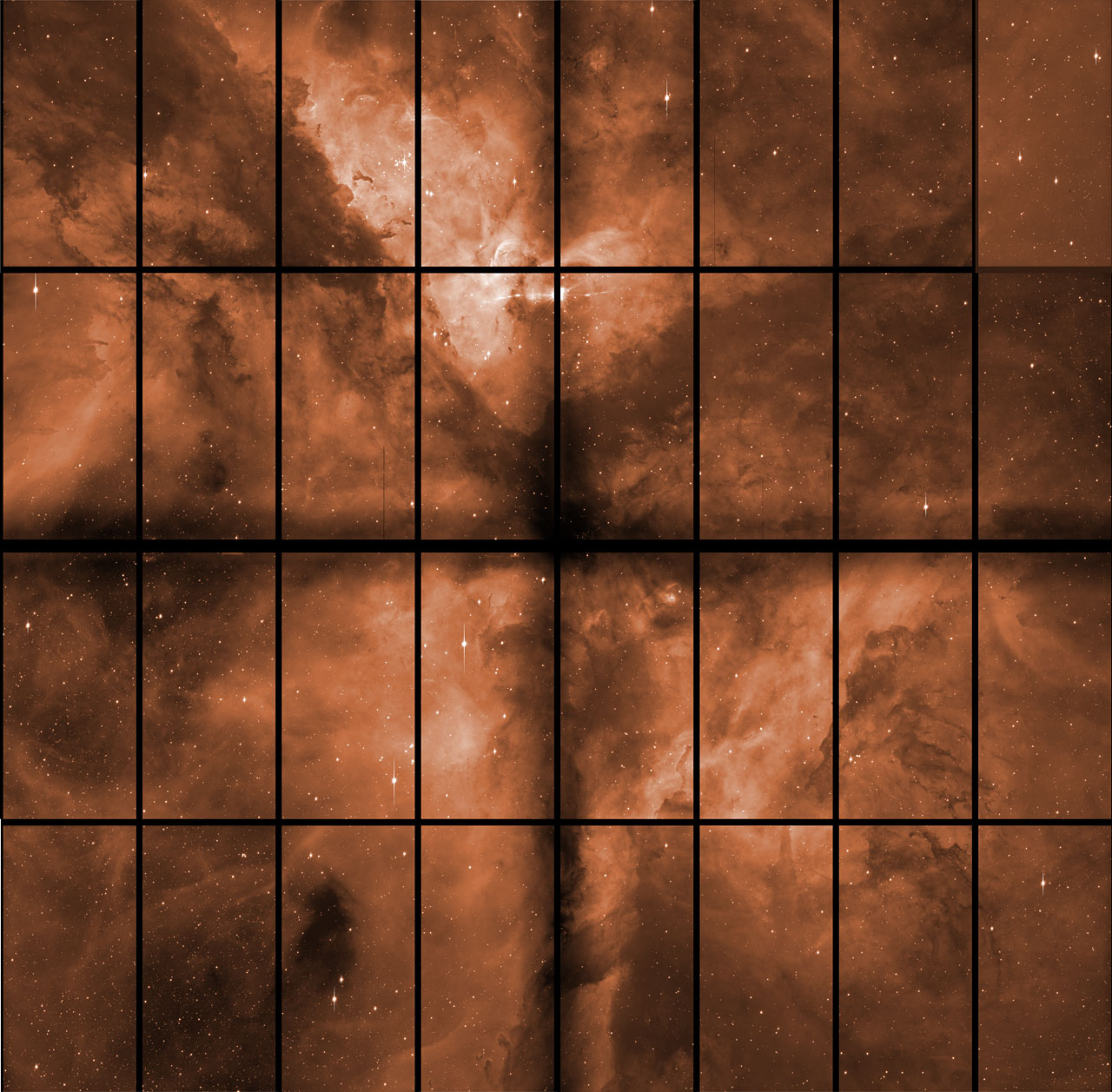OmegaCAM
Omega may be the last letter of the Greek alphabet, but this instrument is by no means at the bottom of the pile. Instrument Scientist Jonathan Smoker helps to ensure that OmegaCAM and the 2.6-metre VLT Survey Telescope (VST) stay on top of their game during his shifts at Paranal Observatory.
OmegaCAM is mounted on the Cassegrain focus of the VST, and is made up of 32 individual CCDs arranged in a mosaic. This allows the VST to observe with a 1 x 1 degree field of view, equating to a whopping 256 million pixels — in comparison, Hubble’s Advanced Camera for Surveys (ACS) is only 16 million pixels, meaning OmegaCAM can produce images 16 times bigger!
Built by a large consortium consisting of institutes based in Germany, Italy and the Netherlands, in conjunction with ESO, OmegaCAM offers 12 different broadband filters, meaning that a large field containing tens of thousands of stars and galaxies can be observed across a wide wavelength range, from 350 nm in the ultraviolet to 1000 nm in the infrared.
 “OmegaCAM also possesses two narrowband filters, designed around the H-alpha emission line,” explains Giacomo Beccari, OmegaCAM Instrument Specialist. H-alpha is a very red spectral line created when the electron inside a hydrogen atom loses energy, and it is important in determining the movement of gas in objects such as stars and nebulae. “This sensitivity allows OmegaCAM to be able to efficiently study young stars accreting mass to form a circumstellar protoplanetary disc, or to characterise the physics of gigantic molecular clouds where new stars and planets form.”
“OmegaCAM also possesses two narrowband filters, designed around the H-alpha emission line,” explains Giacomo Beccari, OmegaCAM Instrument Specialist. H-alpha is a very red spectral line created when the electron inside a hydrogen atom loses energy, and it is important in determining the movement of gas in objects such as stars and nebulae. “This sensitivity allows OmegaCAM to be able to efficiently study young stars accreting mass to form a circumstellar protoplanetary disc, or to characterise the physics of gigantic molecular clouds where new stars and planets form.”
The VST’s primary mirror possesses an active optics system, comprising 108 small, individual motors which make very precise adjustments to the shape of the mirror as the telescope moves in order to get the sharpest images. Thanks to the quality of observations this creates, the VST is currently involved with three large projects: the Kilo Degree Survey (KIDS), VST ATLAS, and the VST Photometric H-alpha Survey of the Southern Galactic Plane (VPHAS+). These surveys all complement surveys being carried out with its sister survey telescope, VISTA, working in the infrared, and investigate a wide range of topics ranging from studies of the Milky Way to exploring the nature of dark matter. A dedicated software system, specially designed for this instrument, has been developed by institutes in Groningen (the Netherlands), and Naples (Italy), to handle the large amount of data that OmegaCAM produces — around 30 terabytes per year, which is the equivalent of having enough MP3s to last 50 years when played continuously!
Science highlights with OmegaCAM
- Science goals: very wide surveys in the visible range.
- Surveys performed by OmegaCam on the VST.
- ESO telescopes (including VST with OmegaCAM) observe first light from gravitational wave source (eso1733)
- Discovery of three different populations of young stars within the Orion Nebula Cluster (eso1723)
- Young stars cooking in the Prawn Nebula (eso1340)
- The most detailed picture ever taken of NGC 253 — a starburst galaxy (eso1152)
- A 16 000 pixel-wide, zoomable image of the Lagoon Nebula is imaged by VPHAS+ — one of three imaging surveys with VST using visible light (eso1403)
|
This raw image, straight from the instrument, was used together with many others to produce the photo of the Carina Nebula further up this page. The images taken with astronomical instruments are always scaled in intensity: the colour information is obtained by taking exposures through different glass filters. The 32 individual 8-megapixel detectors are visible, separated by black gaps. In the final image, these are filled by combining images taken at slightly different positions. Long “bleeds’”, caused by bright stars saturating the detector, are also visible. |
OmegaCAMThe authoritative technical specifications as offered for astronomical observations are available from the Science Operation page.
|


